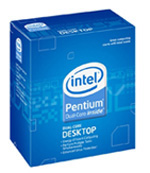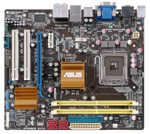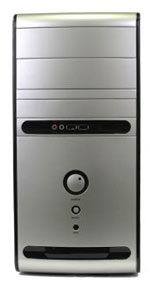Intel Entry-level PC
Intel still owns the pole position in CPU performance, but the area from entry to upper midrange is very competitive between Intel and AMD. In fact, as pointed out in the recent Phenom II Buyers' Guide, AMD is often the better value in the broad midrange category. The only area still dominated by Intel is the very top, where CPUs cost $280 and more.
The one advantage that remains for Intel is that their processors generally overclock better than current AMD CPUs. That has changed with Phenom II in the midrange, but most of today's entry AMD processors still use older designs that do not overclock as well as Intel choices. Overclocking is not normally a consideration in entry computers, but it could be for some buyers, and at the lowest rungs of the CPU ladder Intel processors remain the best overclockers for now.
| Intel Entry-level PC | ||
| Hardware | Component | Price |
| Processor | Intel Pentium Dual-Core E5200 Wolfdale (Dual-core 2.5GHz, 45nm, 65W, 2MB shared L2, 800FSB) | $70 |
| Cooling | CPU Retail HSF | - |
| Video | On-Board | - |
| Motherboard | ASUS P5QL-CM G43 HMDI uATX | $80 |
| Memory | Patriot Viper Model PVS24G6400LLK 4GB DDR2-800 4-4-4 ($52 less $25 Rebate) | $27 |
| Hard Drive | WD Caviar GP WD5000AACS 500GB | $55 |
| Optical Drive | Sony Optiarc Model AD-7240S-OB 24X DVDRW SATA | $24 |
| Audio | On-Board | - |
| Case | SIGMA La Vie LBYWBP Leather Mid-Tower w/ 500W PSU ($65 less $20 Rebate) | $45 |
| Power Supply | 500W Included with Case | - |
| Base System Total | $301 | |
| Display | Acer X193W+BD 19" 5ms Widescreen LCD (1680x1050) | $110 |
| Speakers | Cyber Acoustics CA3090WB 2.1 Gaming Speakers | $16 |
| Input | Microsoft CA9-00001 PS/2 Keyboard and Optical Mouse | $17 |
| Operating System | Microsoft Vista Home Premium SP1 (for System Builders) | $99 |
| Complete System Bottom Line | $543 | |
 |
Our choice for the Intel entry CPU remains the excellent 2.5GHz dual-core E5200 Wolfdale. This 65W rated CPU is built on Intel's 45nm manufacturing that begs you to overclock. The E5200 uses a default 800FSB, so right out of the box the first option for overclocking, if you are so inclined, is to bump it up to 1066 bus. That will give you a 33% overclock and a final speed of 3.33GHz, and it is readily attainable with proper cooling. Even if you never overclock you will be very pleased with the performance of the E5200.
The E5200 is an easier choice now that the price has dropped from $83 a few months ago to $70 today. We do not recommend going lower than an E5200 in an Intel system because the trade-offs in performance for the few dollars saved are too great. The performance of the E1200 at $50, for example, is dismal compared to the E5200, and certainly not a good choice in performance for the $20 saved. The only drawback to this processor choice is the lack of Intel's Virtualization Technology (Intel VT). If running the Windows Virtual PC under Windows 7 for XP Mode (as one example) is important to you, then moving up to the E8x00 range or down to the E6x00 allow the best VT options in this range, although this budget point is no longer valid.
Unlike the numerous AMD product choices in the $60~$80 price range that feature current chipsets and loads of features, the Intel selections are mostly limited to older chipsets like the G31 or NVIDIA GeForce 7100 series. These chipsets are stable, well supported, and are valid options for basic entry-level systems. Intel is promoting the G41 chipset into this price range now and we seriously considered a couple of very good G41 boards, but they featured VGA output or the storage options were limited due to the ICH7 for the type of system we had in mind. Fortunately, ASUS came through with some timely price reductions on their G43 based ASUS P5QPL-CM motherboard and it was an easy decision to choose this particular board for our budget based system.
 |
The P5QL-CM features the latest G43 GMCH along with the ICH10 Southbridge. The GMA X4500 graphics engine does not feature the hardware accelerated H.264/VC-1/MPEG2 decoding capability of the G45 or NVIDIA GeForce 9300 chipsets, but HD video playback is acceptable with a decent processor like the E5200. Otherwise, the performance of the G43 is fine for SOHO applications, flash-based games, and general video duties. However, insert a discrete video card like the HD 4770 and any weaknesses of the G43 chipset go away in an instant.
The P5QL-CM features support for the latest Core 2 Duo, Core 2 Quad, and Pentium/Celeron dual-core processors along with 8GB memory support. The board has a very good layout with one PCIe x16 slot, one PCIe x1 slot, and two PCI slots. The ICH10 does not support RAID but does provide six SATA 3Gb/s ports, one IDE port, and twelve USB 2.0 ports. ASUS includes the 8-channel VT1708B HD audio codec, Realtek RTL8111B Gigabit LAN, and DisplayPort, DVI-D, and VGA video out ports. ASUS based this motherboard on the uATX form factor and it includes a basic accessory kit along with several ASUS specific software applications. The board has proven to be very stable and problem free over the last 30 days. It is not an overclocking demon with our E5200/E7200 being limited to the 345FSB range due to the chipset, but that is more than enough headroom (4.16GHz with the E5200) for most users.
 |
The case and power supply choice are the same Sigma La Vie 500W Mid Tower chosen for the AMD entry system. At a final price of $45 for this good-looking, side-window case and Sigma 500W power supply it is a value that is hard to pass up. If you prefer a smaller Micro ATX case, the HEC 6K28BSOH48D mini tower is a good alternative. HEC is best known as a manufacturer of power supplies. Some are sold under their own name, but most are manufactured for other well known power supply brands. HEC includes a 485W PSU with this attractive mini tower, which should provide plenty of power for your entry build.
Other components are the same ones chosen for the AMD Entry system. Some readers will also notice that our link for the Windows Vista Home Premium System Builders OS is for the 64-bit version. Whether you choose 64-bit or 32-bit, the price of Vista is the same. The choice is yours, but you will need the 64-bit version to fully use the 4GB or more system memory. While 64-bit has made giant strides in drive and component compatibility, if you have an old printer or other peripherals you want to bring from Windows XP to Vista you need to check compatibility very carefully. 32-bit Vista generally works with almost anything that worked with Windows XP, but that is not always true of 64-bit. If you are starting fresh, we recommend choosing 64-bit Vista.
If we compare the two entry-level systems, the winner depends on what is of more value to you. The Intel system is a bit more powerful, but you can move up to a high-end Athlon X2 or a low-end AMD Phenom II X3 for comparable performance at less than $85. If you are an overclocker, the Intel entry may be your best choice. For a gamer, the AMD offers more flexibility for future expansion. For the typical entry-level PC right now and for what the system typically is used for - internet, office, low-end gaming, and low to mid graphics - you can go either route and be very happy.










65 Comments
View All Comments
Zak - Friday, May 15, 2009 - link
I've built a $350 (tower only) AMD PC with on-board graphics using that HEC case. It's really nice looking for the price. The front panel looks grea, well finished. And the steel is sturdy and everything inside is nicely finished. This is really a great value case.Z.
pirspilane - Thursday, May 14, 2009 - link
I installed both the NVIDIA HD Audio driver and the Realtek HD Audio driver. Do I need both? What's the difference?Also, does the LG Blu-ray drive include software for playing Blu-ray, or do I need to buy a separate app. If so, what would you recommend?
JarredWalton - Thursday, May 14, 2009 - link
I believe that the NVIDIA audio drivers are for the HDMI output. I know that's the case on ATI cards that support HDMI. So, if you want HDMI with audio you would need to install both drivers.(Feel free to make fun of me if I'm wrong, though!)
pirspilane - Wednesday, May 20, 2009 - link
You're absolutely right.A few other learning experiences I had:
- Although the M3N78 PRO has a 3-pin connector for the "PWR" fan, there doesn't seem to be any way to control the speed on that fan. It DOES control the speed on "CHA" fan.
- BIOS settings - TLB fix should be disabled; Q-fan must be enabled for the CPU fan to use the Cool n Quiet software, even if you're not using AISuite (which has the Q-fan utility). In fact, you can't use both the Cool n Quiet and AISuite utilities, so I didn't install AISuite.
nubie - Thursday, May 14, 2009 - link
I love you guys, you just built a decent Intel entry-level for $301!!If you happen to have a case/psu/HDD/optical/OS/RAM from an older build you can upgrade with the 4770 for under $300.
(for most people that is what I would recommend, you can buy an older Gateway/eMachines, with a real mATX case, for $100, thus taking care of all of the base requirements, then add the CPU/Mobo/RAM and 4770 and get a decent system out of it for under or around $500)
If you are scrounging for the money you can start with a Celeron chip for $30 and then move up as the budget allows, same with RAM, start with a single 2GB stick if you are really strapped, or a 2x1GB kit.
It is freaking insane how much is available for so little, more so than ever before. (for less than a new current-gen video game console you could upgrade your rig to play current games).
strikeback03 - Friday, May 15, 2009 - link
Would you really trust the PSU in an old emachines/gateway? Esp. if adding a 4770, which likely means using a 4pin to PCI-E power adaptor?nubie - Friday, May 15, 2009 - link
Actually, now that you mention it I have upgraded and/or built several systems with the eMachines/Gateway power supplies and have been very pleased. I have had the Celeron 430/420/440 overclocked past 3ghz on these supplies, with a voltmodded 7900GS @650mhz core clock and no issues at all, no lockups with 3Dmark runs, no issues with Prime95 stress testing.They are rated accurately, are quiet, and inexpensive.
Also, look at what you are asking of them: 1 hard drive, 1 optical drive, 1 35 watt processor. According to: http://extreme.outervision.com/PSUEngine">http://extreme.outervision.com/PSUEngine that is only 215 watts for an e5200 system with a 4830, whereas the Gateway supplies are rated to 250 watt.
If you are using a Celeron 440 with a 4770 it should be just fine, the PSU calculator says 158watts for the 440 with a 4670 (4770 is not yet a choice).
On my regular system I run a PC Power Silencer 470, and I highly recommend it if you plan to add to the system with overclocked Duals or Quads. But I wouldn't hesitate to recommend a cheap system to start with on the lower TDP processors and lighter video cards.
I figure that these older systems came with a P4 or Athlon 90nm in the first place, so a low-power single or quad on 45nm isn't going to be a problem as long as you aren't using a power hungry video card or a rack of hard drives.
barnierubble - Thursday, May 14, 2009 - link
Hi,All the links in the component lists in the latest Under $825 buyers guide have a poor rating in Web of Trust so I would not buy anything from them.
Wesley Fink - Thursday, May 14, 2009 - link
The problem is with Circle of Trust and not our links. Our link engine tries to analyze what you are seeking and route it to the lowest priced vendor it knows about. Often that is Newegg.Circle of trust misreads the forwarding as not completely trustworthy, which is not correct. Our buying links are as reliable as any you will find. They are just analyzed and routed and not direct.
aftlizard - Thursday, May 14, 2009 - link
I wouldn't, and don't. I use this which gives me much better range than my old RF mouse and keyboard, and it saves with clutter.http://www.newegg.com/Product/Product.aspx?Item=N8...">http://www.newegg.com/Product/Product.aspx?Item=N8...